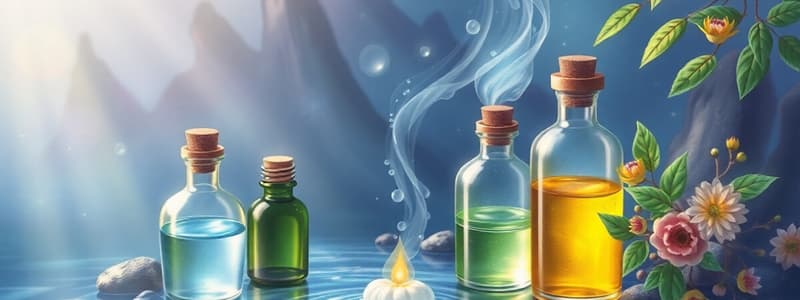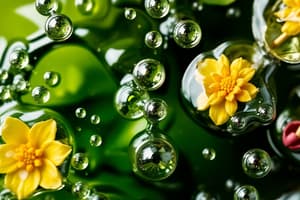Podcast
Questions and Answers
Which characteristic best defines aromatic waters?
Which characteristic best defines aromatic waters?
- Powdered forms of essential oils in distilled water
- Viscous oily liquids with therapeutic properties
- Alcohol-based solutions with a high concentration of aromatic compounds
- Clear aqueous solutions saturated with volatile oils (correct)
What is a primary use of aromatic waters in pharmaceutical preparations?
What is a primary use of aromatic waters in pharmaceutical preparations?
- As solid dosage forms for oral administration
- To enhance the potency of active ingredients
- As a coloring agent for liquid medications
- As intermediate solutions for emulsions and suspensions (correct)
Which of the following aromatic waters is used primarily for its astringent properties?
Which of the following aromatic waters is used primarily for its astringent properties?
- Witch Hazel (Hamamelis Water) (correct)
- Anise Water
- Peppermint Water
- Rose Water
Which method is NOT an official method of preparing aromatic water?
Which method is NOT an official method of preparing aromatic water?
What is the typical concentration characteristic of aromatic waters?
What is the typical concentration characteristic of aromatic waters?
What property do aromatic waters like peppermint and anise possess?
What property do aromatic waters like peppermint and anise possess?
Which volatile substance is NOT commonly used to prepare aromatic waters?
Which volatile substance is NOT commonly used to prepare aromatic waters?
What is the purpose of using flavoring agents in aromatic waters?
What is the purpose of using flavoring agents in aromatic waters?
What is the main reason why chloroform water does not require clarification?
What is the main reason why chloroform water does not require clarification?
What must be done before dispensing chloroform water?
What must be done before dispensing chloroform water?
Which of the following statements about peppermint oil is correct?
Which of the following statements about peppermint oil is correct?
How are concentrated aromatic waters primarily prepared?
How are concentrated aromatic waters primarily prepared?
What can lead to the instability of aromatic waters?
What can lead to the instability of aromatic waters?
What occurs when strong electrolytes are added to aromatic waters?
What occurs when strong electrolytes are added to aromatic waters?
What is a common consequence of using aromatic waters in external dispersions?
What is a common consequence of using aromatic waters in external dispersions?
What is the maximum alcohol content in diluted aromatic water?
What is the maximum alcohol content in diluted aromatic water?
Flashcards
Aromatic Water Composition
Aromatic Water Composition
Aqueous solutions saturated with volatile oils or aromatic substances.
Aromatic Water's Use as Intermediate
Aromatic Water's Use as Intermediate
Used in making other medicines, providing a base for emulsions and suspensions.
Aromatic Water Flavoring
Aromatic Water Flavoring
Gives a pleasant taste for medicines that might be bitter or unpleasant.
Carminative Properties (Some Types)
Carminative Properties (Some Types)
Signup and view all the flashcards
Topical Aromatic Water Uses
Topical Aromatic Water Uses
Signup and view all the flashcards
Aromatic Water Preparation Methods
Aromatic Water Preparation Methods
Signup and view all the flashcards
Low Solubility of Aromatic Substances
Low Solubility of Aromatic Substances
Signup and view all the flashcards
Concentrated Aromatic Water Formulas
Concentrated Aromatic Water Formulas
Signup and view all the flashcards
Chloroform water preparation
Chloroform water preparation
Signup and view all the flashcards
Peppermint water clarification
Peppermint water clarification
Signup and view all the flashcards
Concentrated aromatic waters
Concentrated aromatic waters
Signup and view all the flashcards
Dilution of aromatic waters
Dilution of aromatic waters
Signup and view all the flashcards
Aromatic Water Preparation (Concentrated)
Aromatic Water Preparation (Concentrated)
Signup and view all the flashcards
Aromatic water instability
Aromatic water instability
Signup and view all the flashcards
Stability of aromatic waters (storage)
Stability of aromatic waters (storage)
Signup and view all the flashcards
Aromatic water use in dispersions
Aromatic water use in dispersions
Signup and view all the flashcards
Study Notes
Aromatic Water
- Aromatic waters are clear, aqueous solutions saturated with volatile oils or other aromatic substances.
- They are saturated solutions typically made from volatile oils or similar substances dissolved in distilled water.
- Aromatic waters are not strong medicinal agents due to the low concentration of their active ingredients.
Examples of Aromatic Waters
- Orange oil
- Flower oil
- Peppermint oil
- Rose oil
- Anise oil
- Spearmint oil
- Wintergreen oil
- Camphor
- Chloroform
Aromatic Water Uses
- Used as intermediate solutions for creating other pharmaceutical preparations.
- Can be used as a liquid phase in emulsions and suspensions.
- Used as flavoring agents for water-soluble drugs to mask unpleasant tastes.
- The odors and tastes in aromatic waters come from the volatile substances used in their preparation.
- Some aromatic waters prepared from essential oils (e.g., peppermint and anise) have carminative properties.
Topical Aromatic Water Uses
| Aromatic Water | Use |
|---|---|
| Rose Water | Perfume |
| Hamamelis Water | Astringent |
| Camphor Water | Rubefacient (dilates skin vessels), reduces skin itching, eye wash |
Preparation of Aromatic Water
- Most aromatic substances have low solubility in water.
- The concentration of aromatic material, even in saturated solutions, remains relatively low.
- Common methods for preparation include distillation, solution, and alternative solution methods.
- Concentrated aromatic solutions, containing alcohol or solubilizing agents, are manufactured or created then diluted with water as needed.
Chloroform Water (N.F.) Preparation
- Prepared by the solution method
- No clarification is necessary; excess chloroform stays in the bottle.
- Chloroform is denser than water
- High volatility of chloroform creates constant loss-and-regain equilibrium through evaporation
- The bottle must be shaken vigorously when dispensing, and only the supernatant liquid should be used.
Peppermint Water Preparation
- Peppermint oil is a complex mixture of hydrocarbons (usually terpenes), alcohols, ethers, aldehydes, and ketones.
- Terpenes are the least water-soluble components and are primarily removed through filtration.
- Terpeneless oils (aroma carriers) are made using fractional distillation or extraction.
- Terpeneless oils have a stronger aroma, are more soluble, and are more stable than natural essential oils but are more expensive.
Dilution
- Concentrated aromatic waters are prepared to avoid complications during the clarification process.
- Concentrated aromatic waters are diluted with the appropriate amount of purified water as needed.
- Example: Dilute rose water is made by combining strong rose water with an equal volume of water.
Preparation of Concentrated Aromatic Water
- An alcoholic solution (containing 50-55% alcohol) of the essential oil is combined with water and talc.
- The combination is agitated and filtered after several hours.
- The diluted aromatic water is created by diluting 2 ml of the concentrated aromatic solution to 100 ml with water.
- The finalized product has less than 1.5% alcohol.
Stability of Aromatic Waters
- Aromatic waters are not very stable preparations.
- Improper storage leads to instability; many waters support mold growth.
- Excessive exposure to light and temperature changes can cause aromatic waters to lose their qualities.
- Loss of aroma and cloudiness results from volatile material separation during temperature decreases.
- Addition of strong electrolytes to water, can cause precipitation of volatile components.
- Loss of flavor can occur due to adsorption of aromatic substances onto suspended matter in dispersions
- Oxidative degradation can result from dissolved atmospheric oxygen reacting with aroma-bearing solutes. This process can be accelerated by light and trace metals like iron and copper.
Special Care for Aromatic Waters
- Chloroform water should be stored in light-resistant containers because light speeds up the chloroform's oxidation into phosgene (a poisonous gas).
- Almond water may develop benzoic acid crystals due to benzaldehyde auto-oxidation.
- Aromatic waters made with recently boiled, purified water filtered via bacterial retentive filters in sterile glass containers remain stable for a year.
Studying That Suits You
Use AI to generate personalized quizzes and flashcards to suit your learning preferences.




